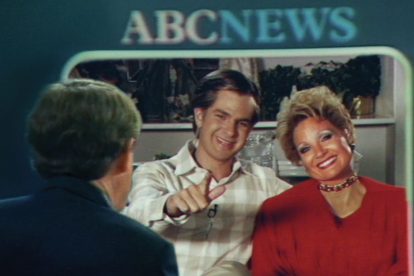Digital Edition
As seen on TV
In ‘The Eyes of Tammy Faye,’ the American dream is not what it seems
Water parks, swirling cameras, gospel choirs, mink coats, televangelists, and, at the center of it all, Tammy Faye. When the PTL (short for “Praise the Lord”) television network began broadcasting to 52 countries around the world, it is difficult to imagine what people not living in the United States would have made of Jim and Tammy Faye Bakker. Theirs was certainly an “American” brand of Christianity. Raised in the Assemblies of God tradition, the Bakkers embraced—perhaps even helped—shape the 1980s “American dream,” with a love for The Tonight Show, Disneyland, wealth, and Jesus. What resulted from this unique combination was feel-good televangelism on a grand scale, the third most popular theme park in the United States, called Heritage USA, and a “prosperity gospel.”
The new film The Eyes of Tammy Faye, and the documentary which it is based on, charts this roller coaster ride in popular American culture through the experiences of its most empathetic, perhaps most intriguing figure, Tammy Faye. this both helps the film and poses a challenge for the filmmakers and the audience. Tammy Faye is much more complex than the often uncharitable caricatures she is portrayed as. Jessica Chastain offers an exceptional and nuanced performance that draws us into Tammy Faye’s experience and meaningful contributions to society.
However, the religious and cultural phenomenon of the Bakkers’ unique brand of televangelism, business, and American Christianity moves the conversation beyond biography and into the spheres of theology, politics, and justice. this is where the film wants to go, most tellingly in its final scene that creates an almost hallucinogenic crosscut sequence juxtaposing humble Christian redemption with American exceptionalism.
Along the way the film and its characters raise some significant questions: Is God at war with a liberal agenda? Is ministry and trust in God intended to bring financial success? Is there a limit to God’s love? Does being a Christian entitle someone to judge others as sinful? What is the role of television, video, and technology in sharing the message of Christianity?
That’s a lot to unpack in two hours, and the film does this somewhat unevenly. More often it attempts to highlight the ways in which Tammy Faye navigates these things. She rejects the notion that there’s a limit to God’s love, preferring instead to use her voice and platform to offer love and compassion rather than judgment. This is most movingly depicted in an interview she conducts with Steve Pieters during the height of the AIDS epidemic. Pieters is a Christian pastor, who in the course of the interview shares that he is gay and has contracted AIDS. Hearing of his suffering and the lack of empathy he receives from Americans who identify themselves as Christian, a teary-eyed Tammy Faye pleads with her viewers to be more Christlike and caring. It’s a beautiful sequence given her audience and the fear and condemnation of the time. It’s made all the more powerful knowing that the film uses almost the exact dialogue taken from the original broadcast.


